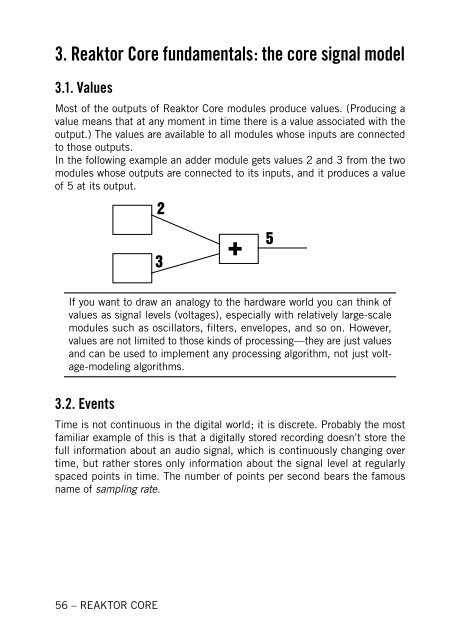1. First steps in Reaktor Core - Native Instruments
1. First steps in Reaktor Core - Native Instruments
1. First steps in Reaktor Core - Native Instruments
Create successful ePaper yourself
Turn your PDF publications into a flip-book with our unique Google optimized e-Paper software.
3. <strong>Reaktor</strong> <strong>Core</strong> fundamentals: the core signal model<br />
3.<strong>1.</strong> Values<br />
Most of the outputs of <strong>Reaktor</strong> <strong>Core</strong> modules produce values. (Produc<strong>in</strong>g a<br />
value means that at any moment <strong>in</strong> time there is a value associated with the<br />
output.) The values are available to all modules whose <strong>in</strong>puts are connected<br />
to those outputs.<br />
In the follow<strong>in</strong>g example an adder module gets values 2 and 3 from the two<br />
modules whose outputs are connected to its <strong>in</strong>puts, and it produces a value<br />
of 5 at its output.<br />
�<br />
56 – REAKTOR CORE<br />
��<br />
��<br />
��<br />
If you want to draw an analogy to the hardware world you can th<strong>in</strong>k of<br />
values as signal levels (voltages), especially with relatively large-scale<br />
modules such as oscillators, filters, envelopes, and so on. However,<br />
values are not limited to those k<strong>in</strong>ds of process<strong>in</strong>g—they are just values<br />
and can be used to implement any process<strong>in</strong>g algorithm, not just voltage-model<strong>in</strong>g<br />
algorithms.<br />
3.2. Events<br />
Time is not cont<strong>in</strong>uous <strong>in</strong> the digital world; it is discrete. Probably the most<br />
familiar example of this is that a digitally stored record<strong>in</strong>g doesn’t store the<br />
full <strong>in</strong>formation about an audio signal, which is cont<strong>in</strong>uously chang<strong>in</strong>g over<br />
time, but rather stores only <strong>in</strong>formation about the signal level at regularly<br />
spaced po<strong>in</strong>ts <strong>in</strong> time. The number of po<strong>in</strong>ts per second bears the famous<br />
name of sampl<strong>in</strong>g rate.<br />
��










